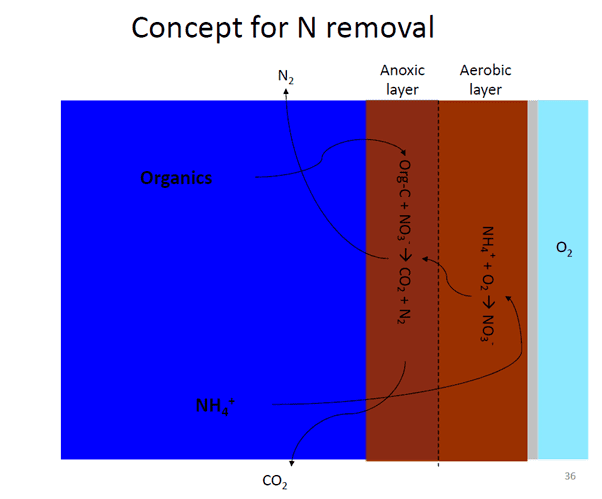The Nitrogen cycle
We know that the biological removal of ammonium from wastewater needs two distinct conventional steps:
1. Nitrification (Aerobic conditions) – Ammonium to Nitrite to Nitrate.
2. Denitrification (Anoxic conditions) – Nitrate to Nitrogen gas.
From the above points, we can see that we need two distinct redox conditions for complete biological nitrogen removal. We could do that in a single reactor due to mass transfer limitations induced in the biofilms.
The biofilm architecture in the EBR reactor allows a diverse community of Bacteria, Archaea, and fungus to co-exist in a single place. The mass transport limitations of electron acceptor (i.e. oxygen) and electron donor (carbon) allow for simultaneous nitrification and denitrification in a single reactor.
For instance, the following figure depicts the mass transfer limitations in a membrane bioreactor. The outer layer is aerobic and the inner layer is anoxic. A similar phenomenon can be observed in EBR. The microbes attach to the packing media to form biofilms. The packing media also acts as a carbon source (electron donor). The ammonium gets converted to Nitrate in the aerobic layers, i.e. the outer layer of the biofilm which is exposed to the atmosphere. The nitrate diffuses into the inner layers of the biofilms. But oxygen is absent due to diffusion limitations. The oxygen would have been consumed by the heterotrophs, nitrifying and other microbial communities before it reaches the inner layers of the biofilm. Hence, the inner layer has nitrate (electron acceptor) and carbon (electron donor) and a denitrification reaction take place.
 Credits:
Credits:
Credits: Prof. Oskar Modin, Chalmers University of Technology, Sweden.
P.S. What causes the mass transfer/diffusion limitations within a biofilm?
It’s simply the difference in the rate of diffusion of the substrate and the rate of substrate consumption by the microbes.
For instance, in the state of the art wastewater treatment technology aerobic granular sludge. Typically the outer layers are dominated by heterotrophs. Heterotrophs consumes organic matter/carbon in the wastewater for their metabolism. It uses oxygen as an electron acceptor for breaking down carbon. The growth rate of the heterotrophs is highest and dominates the outer layers of the granules rapidly. It consumes all the available oxygen before the oxygen molecule enters the inner layers. Hence, the inner layer becomes devoid of oxygen. The inner layers become anoxic if nitrate is present, and completely anaerobic at the inner core. The figure below shows a typical granule structure.
A typical aerobic granule structure is shown. The outer layer is aerobic. The oxygen (substrate) gets consumed by the heterotrophs (for organic carbon oxidation), and autotrophs (for nitrification) in the outer aerobic layers. The end product of the two-step nitrification process is Nitrate and it diffuses into the inner layers. The inner layers which are devoid of oxygen become anoxic due to the presence of nitrate. Once, the nitrate is also consumed by the microbes for denitrification, the inner core becomes anaerobic. i.e. absence of electron acceptor (oxygen and nitrate).